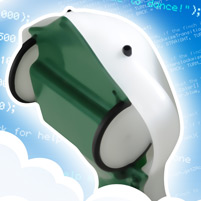A BirdBrain Idea
 A new product from Carnegie Mellon University’s famous Robotics Institute (RI) was designed specifically to make intro classes to computer science engaging for students.
A new product from Carnegie Mellon University’s famous Robotics Institute (RI) was designed specifically to make intro classes to computer science engaging for students.Finch, a two-wheeled robot with bird-like features, can be programmed by a novice to talk, dance or even make its beak glow in response to cold temperatures.
The simple look of the tabletop robot is deceptive. Based on four years of educational research sponsored by the National Science Foundation, Finch includes a number of features that could keep students busy for a semester or longer.
“Students are more interested and more motivated when they can work with something interactive and create programs that operate in the real world,” said CMU’s Tom Lauwers.
Lauwers earned his Ph.D. in robotics from the university in 2010 and is now an instructor in the RI’s CREATE Lab.
He added, “We packed Finch with sensors and mechanisms that engage the eyes, the ears — as many senses as possible.”
Lauwers has launched a startup company, BirdBrain Technologies, to produce Finch. The company now sells them online at www.finchrobot.com for $99 each.
“Our vision is to make Finch affordable enough that every student can have one to take home for assignments,” Lauwers said.
He developed the robot with Illah Nourbakhsh, associate professor of robotics and director of the CREATE Lab.
Less than a foot long, Finch easily fits in a backpack and is rugged enough to survive being hauled around (and occasionally dropped).
Finch includes temperature and light sensors, a three-axis accelerometer and a bump sensor. It has color-programmable LED lights, a beeper and speakers.
With a pencil inserted in its tail, Finch can be used to draw pictures. It can be programmed to be a moving, noise-making alarm clock.
It even has uses beyond a robot; its accelerometer enables it to be used as a 3-D mouse to control a computer display.
Robot kits suitable for students as young as 12 are commercially available, but often cost more than the Finch, Lauwers said.
Finch currently can be programmed with the Java and Python languages widely used by educators.
A number of assignments are available on the Finch Robot website to help teachers drop Finch into their lesson plans, and the website allows instructors to upload their own assignments or ideas in return for company-provided incentives.
“Computer science now touches virtually every scientific discipline and is a critical part of most new technologies. Yet U.S. universities saw declining enrollments in computer science through most of the past decade,” Nourbakhsh said.
“If Finch can help motivate students to give computer science a try, we think many more students will realize that this is a field that they would enjoy exploring.”
The robot has been classroom-tested at the Community College of Allegheny County, Pa., and by instructors in high school, university and after-school programs.
Related Links: Finch Website | Robotics Institute | CREATE Lab | Watch: The Finch in Three Minutes
